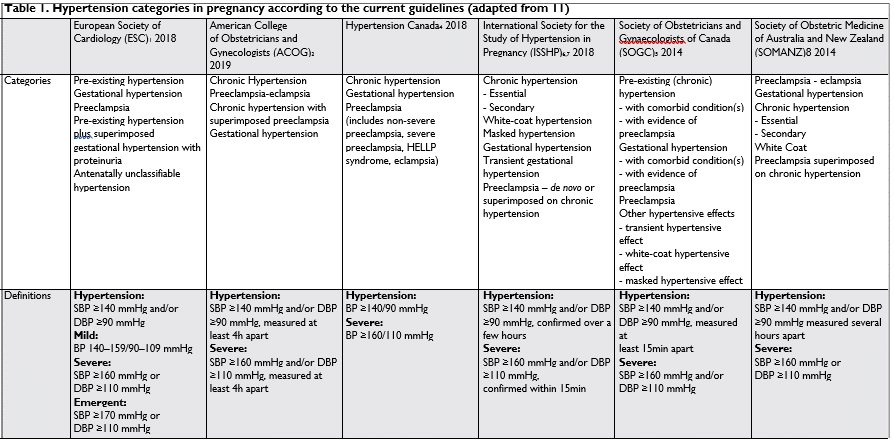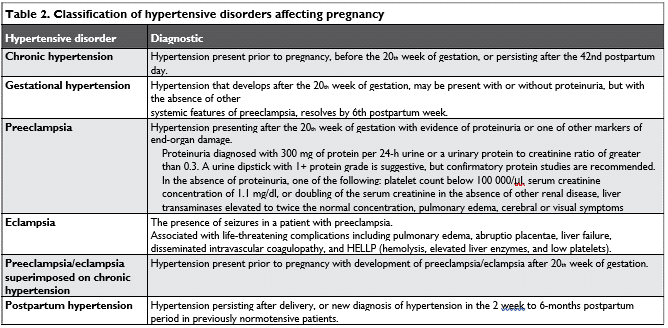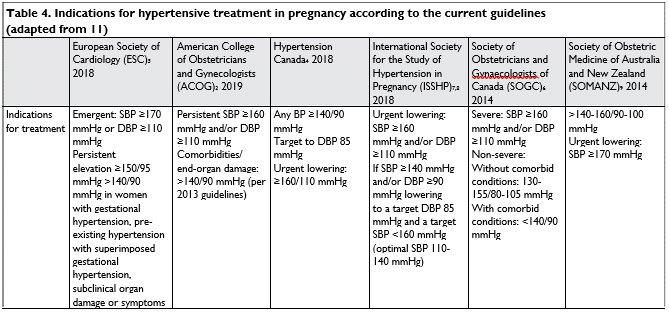Cristian Statescu1,2, Radu Sascau1,2, Rodica Radu1,2, Ioana Madalina Zota1,2, Teodor Flaviu Vasilcu1,2, Larisa Anghel1,2
1 „Prof. Dr. George I. M. Georgescu” Institute for Cardiovascular Diseases, Iasi, Romania
2 Discipline of Cardiology, „Grigore T. Popa” University of Medicine and Pharmacy, Iasi, Romania
Abstract: Hypertension is a relatively common finding during pregnancy, complicating up to 10% of pregnancies and rank as the second most common cause of maternal death in developed countries. Hypertensive disorders of pregnancy repre-sent an umbrella term that includes preexisting and gestational hypertension, preeclampsia, and eclampsia. The goal of blood pressure control in hypertensive pregnancy disorders is to reduce the risk of end-organ damage, the maternal and fetal morbidity and mortality. The aim of our study is to review the pathophysiology and management of hypertensive disorders of pregnancy, according to the current guidelines.
Keywords: hypertension, pregnancy, gestational hypertension, preeclampsia, eclampsia.
INTRODUCTION
Hypertensive disorders in pregnancy are the most common complications, affecting up to 10% of preg-nancies. They represent a major cause of maternal and fetal morbidity and mortality worldwide, being associ-ated with adverse maternal and fetal outcomes such as: placental abruption, stroke, multiple organ failure, and disseminated intravascular coagulation and also fetal high-risk of intrauterine growth retardation (25% of cases of preeclampsia), pre-maturity (27% of cases of pre-eclampsia), and intrauterine death (4% of cases of pre-eclampsia)1,2.
DEFINITION AND CLASSIFICATION
The defi nition of hypertension in pregnancy has not always been standardized, but the most guidelines re-commendations are currently a systolic blood pressu-re (SBP) ≥140mmHg and/or a diastolic blood pressu-re (DBP) ≥90mmHg, on two separate measurements (Table 1)1,3-8. According to the severity of hypertensi-on, we may define two different categories:
Non-severe hypertension: any values between SBP 140-159 mmHg and DBP 90-109 mmHg. Sometimes this category is further broken into mild (140-149/90-99 mmHg) and moderate (150-159/100-109 mmHg)9.
Severe hypertension: SBP ≥160mmHg and/or DBP ≥110mmHg, which is associated with a high risk of hypertensive encephalopathy10.
Based on the context in which the hypertension is first identifi ed, all the international guidelines accept the following categories: chronic (pre-dating pregnancy or diagnosed before 20 weeks of pregnancy) or de novo (either preeclampsia or gestational hypertension)1,3-8 (Table 2).
The ESC Guidelines suggest that gestational hyper-tension should resolve within 42 days postpartum, while other studies support the concept that preg-nancy hypertension may persist for up to 12 weeks after delivery1,17,18.

PATHOPHYSIOLOGY OF HYPERTENSION
Women over the age of 35 years, those of black or latin descent, with preexisting hypertension or with diabetes have a higher risk of hypertensive disorders of pregnancy12,13. All pregnant women should undergo routine measurement of blood pressure and urinalysis at check-ups in the gestational and postpartum period, regardless of baseline risk profi le. All the hypertensive disorders of pregnancy can result in preeclampsia and eclampsia, but the underlying pathophysiology that upholds this transition is not well understood. It is thought to be related to a mechanism of reduced pla-cental perfusion inducing systemic vascular endotheli-al dysfunction14,15. The placental hypoxia will induce a cascade of inflammatory events, disrupting the balance of angiogenic factors, and inducing platelet aggrega-tion, all of them resulting in endothelial dysfunction manifested clinically as the preeclampsia syndrome15,16. Preeclampsia occurs in up to 35% of women with ges-tational hypertension and up to 25% of those with chronic hypertension17,18. Women that have a high or moderate risk of pre-eclampsia (Table 3) should take a dose of 100-150 mg aspirin daily from week 12 to week 36-37, according to the current European Gui-deline1,16.
Calcium supplementation (1.5-2 g daily, orally) is recommended by the European Guideline for the pre-vention of pre-eclampsia only in women with a low dietary intake of calcium (<600 mg/day)1.
Pravastatin may be a promising therapeutic for pre-eclampsia, but his role is currently under investigation, also considering that statins are currently contraindi-cated in pregnancy. Only small case series of pree-clamptic women treated with pravastatin demonstra-ted amelioration of endothelial dysfunction and de-crease in antiangiogenic biomarkers in placentas, and this benefi t derives from their pleiotropic antioxidant, anti-infl ammatory and antithrombotic effect19,20.
TARGET BLOOD PRESSURE
The goal of blood pressure control in hypertensive pregnancy disorders is to reduce the risk of end-organ damage, which is generally low in chronic and gesta-tional hypertension. On the other hand, patients with preeclampsia/HELLP/eclampsia, have a high risk of ma-ternal and fetal health and treatment goal is to optimi-ze the timing of delivery, for safe outcomes of mother and fetus. There is no debate that blood pressure ne-eds to be controlled to less than 160/110 mmHg, but how aggressively to treat non-severe hypertension re-mains controversial1,3-8 (Table 4).
For patients with chronic hypertension or gestatio-nal hypertension, blood pressure treatment goals are around 140 mmHg/90 mmHg once blood pressure re-aches systolic 150-160 mmHg or diastolic pressure of 100-105 mmHg21,22. However, excessive blood pressu-re lowering may present fetal harm due to placental hypoperfusion and reduction of blood pressure below 110/80 mmHg should be avoided23.
In patients with preeclampsia without severe featu-res, twice weekly maternal and fetal testing should be carried out from diagnosis until delivery for screening of severe preeclampsia/eclampsia such as headache, vision changes, epigastric pain or shortness of breath. In these patients are also recommended weekly labo-ratory testing (24-hour urine protein or protein/crea-tinine ratio, liver transaminases, serum creatinine, and complete blood count)11.
In patients with severe preeclampsia, continuation of pregnancy has significant risk for mother (dissemi-nated intravascular coagulopathy, renal or liver failu-re, acute respiratory distress syndrome, myocardial infarction or stroke) and the fetus (uteroplacental insufficiency or preterm birth)24,25. When severe pree-clampsia, HELLP or eclampsia is diagnosed at the 24th gestation week, before fetal viability, some guidelines recommend delivery of the fetus after maternal stabi-lization3. In patients with severe hypertension without end-organ damage, blood pressure needs to be redu-ced to less than 160/110 mmHg, with an initial reduc-tion of less than 25% in the first hours of treatment, and a more gradual decrease in the following hours. If hypertension is associated with end-organ complica-tions (pulmonary edema or acute kidney injury), the blood pressure needs to be decreased much faster18.
Magnesium sulfate is recommended for seizure prophylaxis in patients with preeclampsia with severe features (proteinuria or neurological complications) or eclampsia3.



TREATMENT OF CHOICE FOR URGENT/SEVERE HYPERTENSION IN PREGNANCY
There are only few randomized clinical trials of anti-hypertensive medications in pregnancy26,27. The aim of treating severe hypertension is to prevent congestive heart failure, ischemic or hemorrhagic stroke, myo-cardial infarction and renal injury, and literature data suggests that antihypertensive therapy should be ad-ministered as soon as possible, preferably within 30-60 minutes. The three agents most commonly used for urgent blood pressure control in pregnancy are in-travenous hydralazine or labetalol and nifedipine with immediate release. (Table 5)
Of these, labetalol is often considered a fi rst-line agent due to fewer adverse side effects28. Use of i.v.
urapidil can also be considered, as second line treat-ment, according to the European Society of Cardiology Guideline1. Sodium nitroprusside should only be used as the drug of last choice since prolonged treatment is associated with an increased risk of fetal cyanide toxicity, especially in women with impaired renal func-tion1,29. Nitroglycerin, given as an i.v. infusion of 5 μg/ min, and gradually increased every 3-5 min to a ma-ximum dose of 100 μg/min is the drug of choice for patients with pre-eclampsia and pulmonary edema1.
TREATMENT OF CHOICE FOR NON-SEVERE HYPERTENSION IN PREGNANCY
The most commonly used as first-line oral medication for the management of non-severe hypertension in pregnancy are methyldopa, labeta-lol and nifedipine. (Table 6) The central adrenergic inhibitor methyldopa has commonly used as first-line treatment. Because it has been associated with worsening of postpartum depression, some gui-delines recommend discontinuation of the drug in the postpartum period31,32. Labetalol is a nonselec-tive -blocker with vascular -receptor blocking ability, but some data suggest that it may be associa-ted with small for gestation age infants33. Nifedipine is the most commonly used calcium channel blocker in pregnancy, with no adverse perinatal effects. Hydra-lazine and hydrochlorothiazide may also be used but as second line treatment for patients with non-seve-re hypertension, but only per ACOG and Hyperten-sion Canada Guidelines, because they may worsen the hypovolemic state, leading to placental hypoperfusi-on3,4. Thiazide diuretics are not recommended by the other guidelines. Hydralazine may be also associated with hypospadias in the first trimester of pregnancy as well as thrombocytopenia and neonatal lupus-like syndrome in third trimester exposure. It may be con-sidered to be co-administrated with a sympatholytic agent such as methyldopa or a beta-blocker34,35.
All the guidelines contraindicate angiotensin-con-verting enzyme inhibitors and angiotensin receptor blockers throughout pregnancy due to risks of oli-gohydramnios, intrauterine growth restriction, hypo-calvaria, renal dysplasia, anuria and neonatal death36.


PROGNOSIS
About 29-57% of hypertensive disorders of pregnancy resolve within three days of delivery, 50-85% resolve by seven days of delivery and all pregnancy-associated hypertension, by definition, should resolve by the 42nd postpartum day (six weeks)31,37. In case that hyperten-sion persists beyond the 6th postpartum week, workup for secondary hypertension and renovascular disease may be indicated.
Postpartum hypertension is common in the first week and methyldopa should be avoided because of the risk of depression. Most of the antihypertensive drugs are present at very low concentrations into breast milk, but drugs such as propranolol and nifedi-pine have breast milk concentrations similar to those in maternal plasma1,38.
The occurrence of a hypertensive condition during pregnancy has implications for the woman in sub-sequent pregnancies and confers a higher lifetime risk of hypertension, cardiovascular disease, chronic kid-ney disease and diabetes mellitus39,40. In order to avoid complications in subsequent pregnancies and to re-duce maternal cardiovascular risk, lifestyle modificati-ons, annual visits to a primary care physician to check blood pressure and metabolic factors are primarily re-commended. The earlier the onset of hypertension in the fi rst pregnancy, the higher the risk of recurrence in a subsequent pregnancy1.
CONCLUSIONS
Hypertensive disorders of pregnancy affect up to 10% pregnancies and have implications on maternal and fe-tal health. Despite the differences in current guidelines, there appears to be consensus that severe hypertensi-on and non-severe hypertension with evidence of end-organ damage need to be controlled, and intravenous hydralazine, labetalol and immediate release nifedipine remain the drugs of choice. Methyldopa, labetalol and nifedipine (extended-release) are the most commonly accepted first-line agents for non-severe hypertension, while renin-angiotensin-aldosterone system inhibitors remain contraindicated. Management of hypertensive disorders in pregnancy requires increased surveillance and optimization of the timing of delivery, in order to reduce maternal and fetal complications.
Conflict of interest: none declared.
References
1. Regitz-Zagrosek V, Roos-Hesselink JW, Bauersachs J, Blomström-Lundqvist C, Cífková R, De Bonis M, Iung B, Johnson MR, Kintscher U, Kranke P, Lang IM, Morais J, Pieper PG, Presbitero P, Price S, Ro-sano GMC, Seeland U, Simoncini T, Swan L, Warnes CA. 2018 ESC guidelines for the management of cardiovascular diseases during pregnancy. Eur Heart J 2018; 39: 3165–3241.
2. VillarJ,CarroliG,WojdylaD,AbalosE,GiordanoD,Ba’aqeelH,FarnotU, Bergsjo P, Bakketeig L, Lumbiganon P, Campodonico L, Al-Mazrou Y, Lindheimer M, Kramer M. Preeclampsia, gestational hypertension and intrauterine growth restriction, related or independent condi-tions? Am J Obstet Gynecol 2006; 194:921–931.
3. ACOG practice bulletin no. 202: gestational hypertension and preeclampsia. Obstet Gynecol 2019; 133: e1–e25.
4. Butalia S, Audibert F, Cote AM, Firoz T, Logan AG, Magee LA, Mun-dle W, Rey E, Rabi DM, Daskalopoulou SS, Nerenberg KA. Hyper-tension Canada’s 2018 guidelines for the management of hyperten-sion in pregnancy. Can J Cardiol 2018; 34(5): 526–531.
5. Magee LA, Pels A, Helewa M, Rey E, von Dadelszen P. J Obstet Gyn-aecol Can 2014; 36: 416– 441.
6. Tranquilli AL, Dekker G, Magee L, Roberts J, Sibai BM, Steyn W, Zeeman GG, Brown MA. The classification, diagnosis and man-agement of the hypertensive disorders of pregnancy: A revised state-ment from the ISSHP. Pregnancy Hypertens 2014; 4(2): 97–104.
7. Brown MA, Magee LA, Kenny LC, Karumanchi SA, McCarthy FP, Saito S, Hall DR, Warren CE, Adoyi G, Ishaku S. The hyperten-sive disorders of pregnancy: ISSHP classification, diagnosis & man-agement recommendations for international practice. Pregnancy Hy-pertens 2018; 13: 291–310.
8. Lowe SA, Bowyer L, Lust K, McMahon LP, Morton MR, North RA, Paech MJ, Said JM. The SOMANZ guidelines for the manage-ment of hypertensive disorders of pregnancy 2014. Aust N Z J Ob-stet Gynaecol 2015; 55: 11–16.
9. Visintin C, Mugglestone MA, Almerie MQ, Nherera LM, James D, Walkinshaw S. Management of hypertensive disorders during pregnancy: summary of NICE guidance. BMJ 2010; 341: c2207.
10. Bernstein PS, Martin JN Jr, Barton JR, Shields LE, Druzin ML, Scavone BM, Frost J, Morton CH, Ruhl C, Slager J, Tsigas EZ, Jaffer S, Menard MK. Consensus bundle on severe hypertension during pregnancy and the postpartum period. J Obstet Gynecol Neonatal Nurs 2017; 46: 776–787.
11. Braunthal S, Brateanu A. Hypertension in pregnancy: pathophysiogy and treatment. SAGE Open Medicine 2019; 7: 1-15.
12. Nakagawa K, Lim E, Harvey S, Miyamura J, Juarez DT. Racial/ethnic disparities in the association between preeclampsia risk factors and preeclampsia among women residing in Hawaii. Matern Child Health J 2016; 20: 1814–1824.
13. Radu R, Sascău RA, Stătescu C. Hipertensiunea arterială endocrină şi de sarcină. In Medicină Internă: patologie respiratorie, cardiovasculară şi hematologică. Eds: L Şorodoc, AO Petriş, C Stătescu, C Rezuş, ID Alexa. SEDCOM LIBRIS, Iaşi, 2019, 437-456.
14. Lungeanu-Juravle L, Patrascu N, Deleanu OC, Cinteza M. The role of obstructive sleep apnea in developing gestational hypertension and preeclampsia. Maedica (Buchar). 2016;11(4):330–333.
15. Ngene NC and Moodley J. Role of angiogenic factors in the patho-genesis and management of pre-eclampsia. Int J Gynaecol Obstet 2018; 141(1): 5–13.
16. Atallah A, Lecarpentier E, Goffinet F. Aspirin for prevention of pre-eclampsia. Drugs 2017; 77: 1819–1831.
17. Seely EW and Ecker J. Chronic hypertension in pregnancy. Circula-tion 2014; 129: 1254–1261.
18. Magee LA and von Dadelszen P. State-of-the-art diagnosis and treat-ment of hypertension in pregnancy. Mayo Clin Proc 2018; 93(11): 1664–1677.
19. Katsi V, Georgountzos G, Kallistratos MS. The role of statins in pre-vention of preeclampsia: a promise for the future. Front Pharmacol 2017; 8: 247.
20. Brownfoot FC, Tong S, Hannan NJ. Effects of pravastatin on human placenta, endothelium, and women with severe preeclampsia. Hy-pertension 2015; 66(3): 687–697.
21. American College of Obstetricians and Gynecologists and Task Force on Hypertension in Pregnancy. Hypertension in pregnancy. Report of the American College of Obstetricians and Gynecologists’ Task Force on Hypertension in Pregnancy. Obstet Gynecol 2013; 122: 1122–1131.
22. Von Dadelszen P and Magee LA. Fall in mean arterial pressure and fetal growth restriction in pregnancy hypertension: an updated metaregression analysis. J Obstet Gynaecol Can 2002; 24: 941–945.
23. Magee LA, von Dadelszen P, Rey E. Less-tight versus tight control of hypertension in pregnancy. N Engl J Med 2015; 372: 407–417.
24. Ganzevoort W and Sibai BM. Temporising versus intervention-ist management (preterm and at term). Best Pract Res Clin Obstet Gynaecol 2011; 25: 463–476.
25. Publications Committee, Society for Maternal-Fetal Medicine and Sibai BM. Evaluation and management of severe preeclampsia before weeks’ gestation. Am J Obstet Gynecol 2011; 205: 191–198.
26. Magpie Trial Follow-Up Study Collaborative Group. The Magpie Tri-al: a randomised trial comparing magnesium sulphate with placebo for pre-eclampsia. Outcome for women at 2 years. BJOG Int J Ob-stet Gynaecol 2007; 114: 300–309.
27. Cifkova R. Why is the treatment of hypertension in pregnancy still so difficult? Expert Rev Cardiovasc Ther 2011; 9: 647–649.
28. Vigil-De Gracia P, Lasso M, Ruiz E. Severe hypertension in pregnan-cy: hydralazine or labetalol. A randomized clinical trial. Eur J Obstet Gynecol Reprod Biol 2006; 128: 157–162.
29. Sass N, Itamoto CH, Silva MP, Torloni MR, Atallah AN. Does sodium nitroprusside kill babies? A systematic review. Sao Paulo Med J Rev Paul Med 2007; 125: 108–111.
30 ACOG practice bulletin no. 203: chronic hypertension in pregnancy. Obstet Gynecol 2019; 133: e26–e50.
31. Bibbins-Domingo K, Grossman David C, Curry SJ. Screening for pre-eclampsia: US preventive services task force recommendation state-ment. JAMA 2017; 317: 1661–1667.
32. Hypertension in Pregnancy: The Management of Hypertensive Dis-orders During Pregnancy. NICE clinical guidelines No. 107; 2010.
33. Magee LA and Duley L. Oral beta-blockers for mild to moderate hypertension during pregnancy. Cochrane Database Syst Rev 2003; CD002863.
34. Al-Balas M, Bozzo P, Einarson A. Use of diuretics during pregnancy. Can Fam Physician 2009; 55: 44–45.
35. Lecarpentier E, Tsatsaris V, Goffinet F, Cabrol D, Sibai B, Haddad B. Risk factors of superimposed preeclampsia in women with essential chronic hypertension treated before pregnancy. PLoS One 2013; 8: e62140.
36. Cooper WO, Hernandez-Diaz S, Arbogast PG, Dudley JA, Dyer S, Gideon PS, Hall K, Ray WA. Major congenital malformations after first-trimester exposure to ACE inhibitors. N Engl J Med 2006; 354: 2443–2451.
37. Stepan H, Nordmeyer AK, Faber R. Proteinuria in hypertensive pregnancy diseases is associated with a longer persistence of hyper-tension postpartum. J Hum Hypertens 2005 20: 125–128.
38. Panaitescu AM, Peltecu G. Afecţiuni medicale în sarcină. Editura Academiei Române, Bucureşti, 2017.
39. Magnussen EB, Vatten LJ, Smith GD, Romundstad PR. Hypertensive disorders in pregnancy and subsequently measured cardiovascular risk factors. Obstet Gynecol 2009; 114: 961–970.
40. Männisto T, Mendola P, Vääräsmäki M, Järvelin MR, Hartikainen AL, Pouta A, Suvanto E. Elevated blood pressure in pregnancy and subsequent chronic disease risk. Circulation 2013; 127: 681–690.
 This work is licensed under a
This work is licensed under a